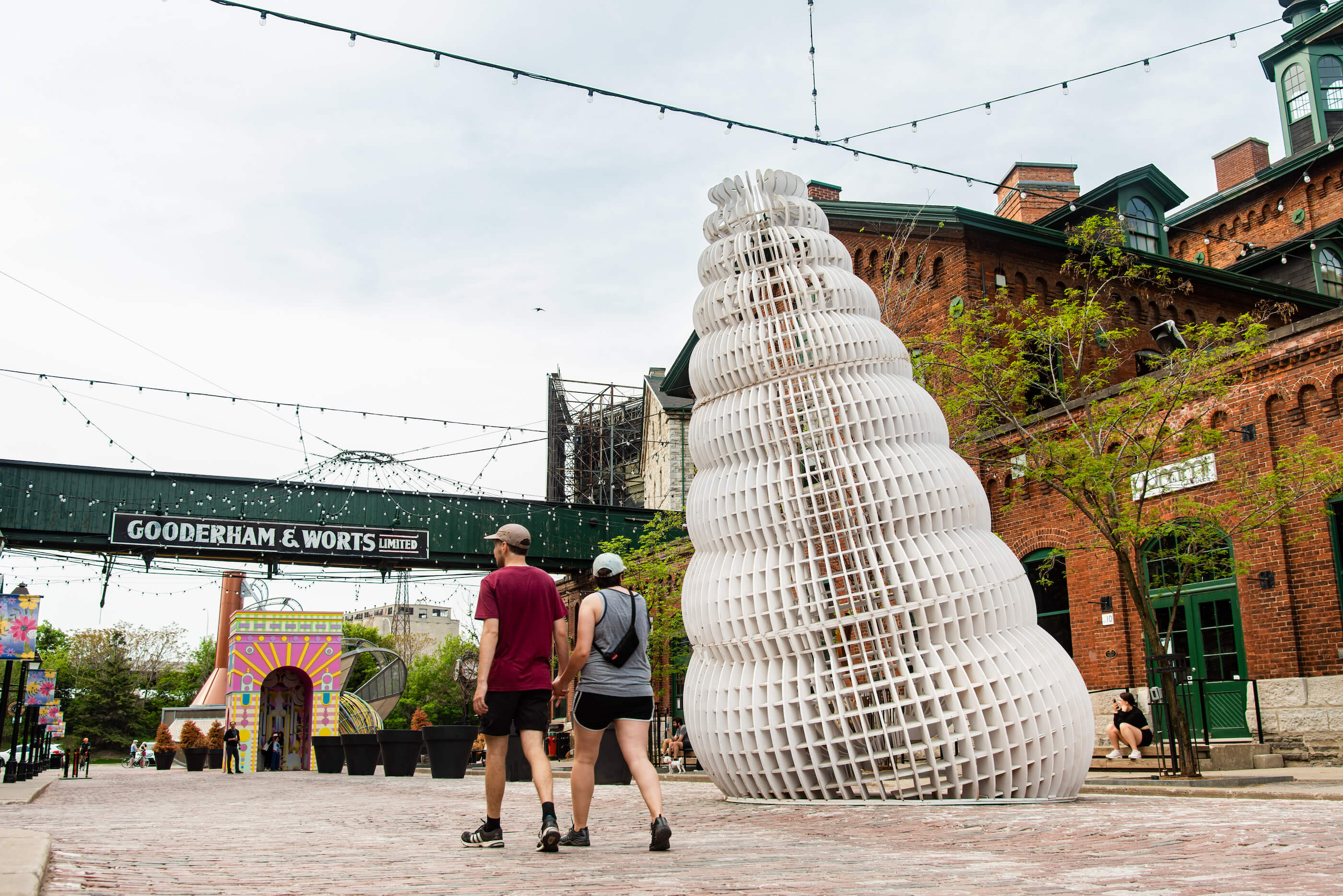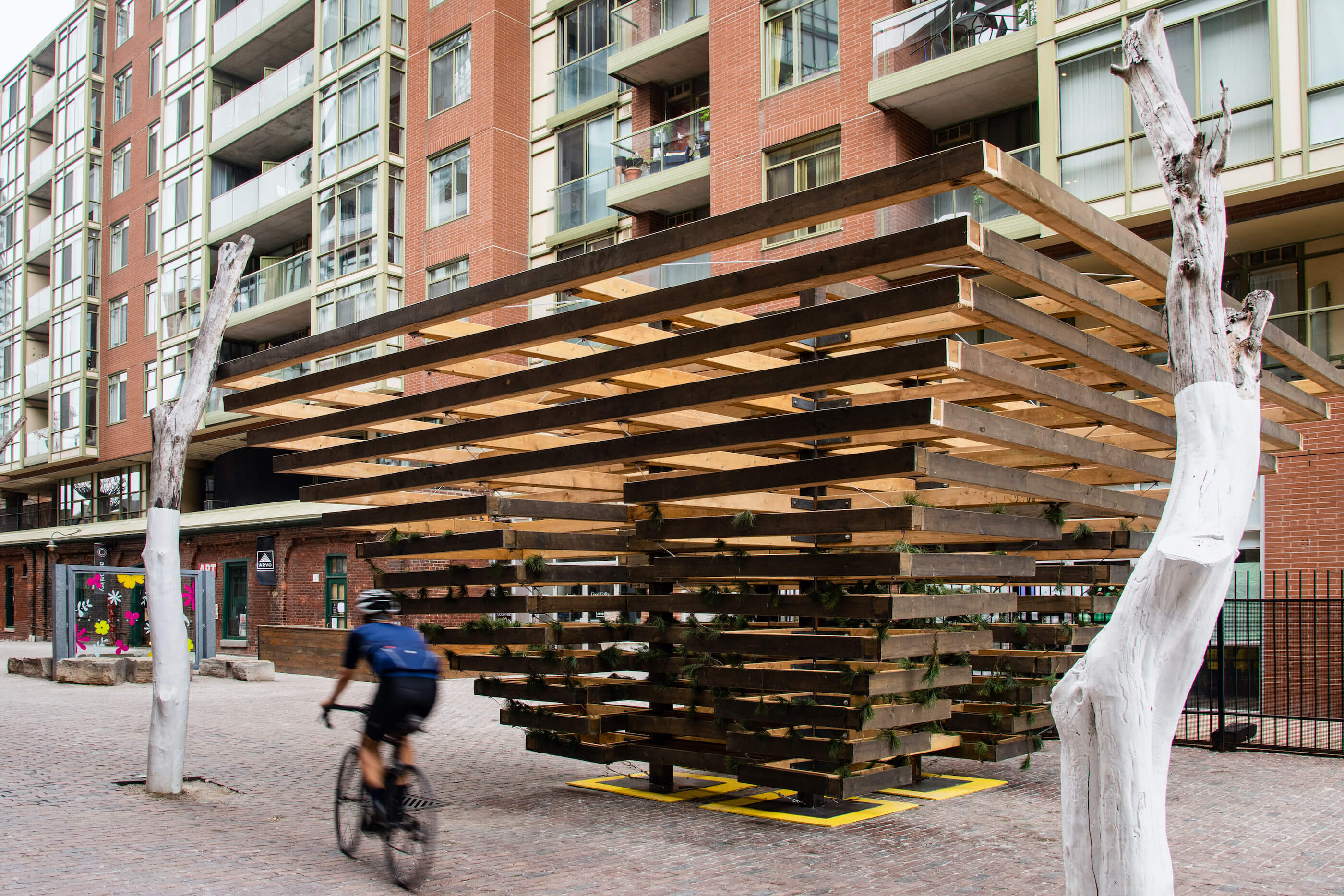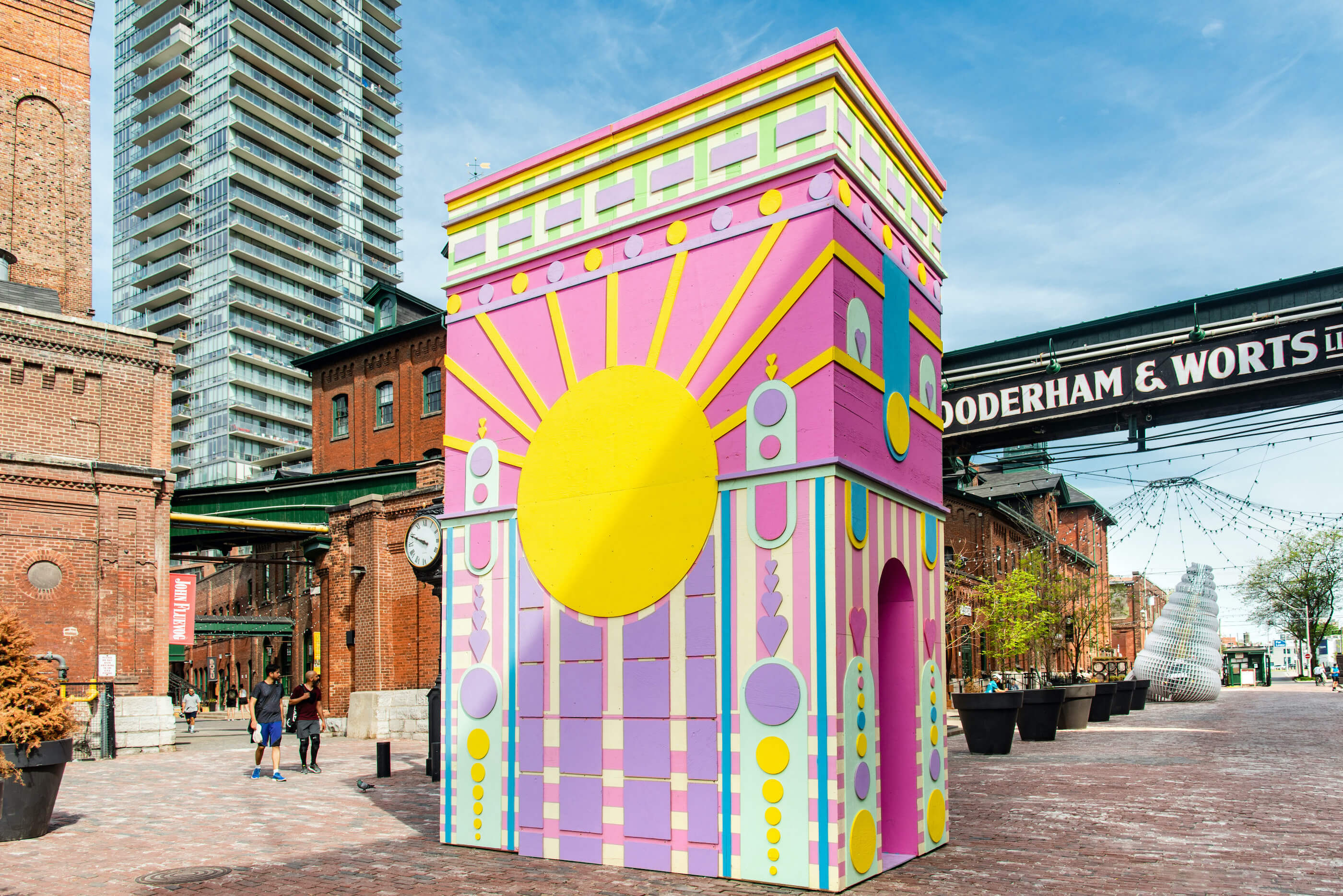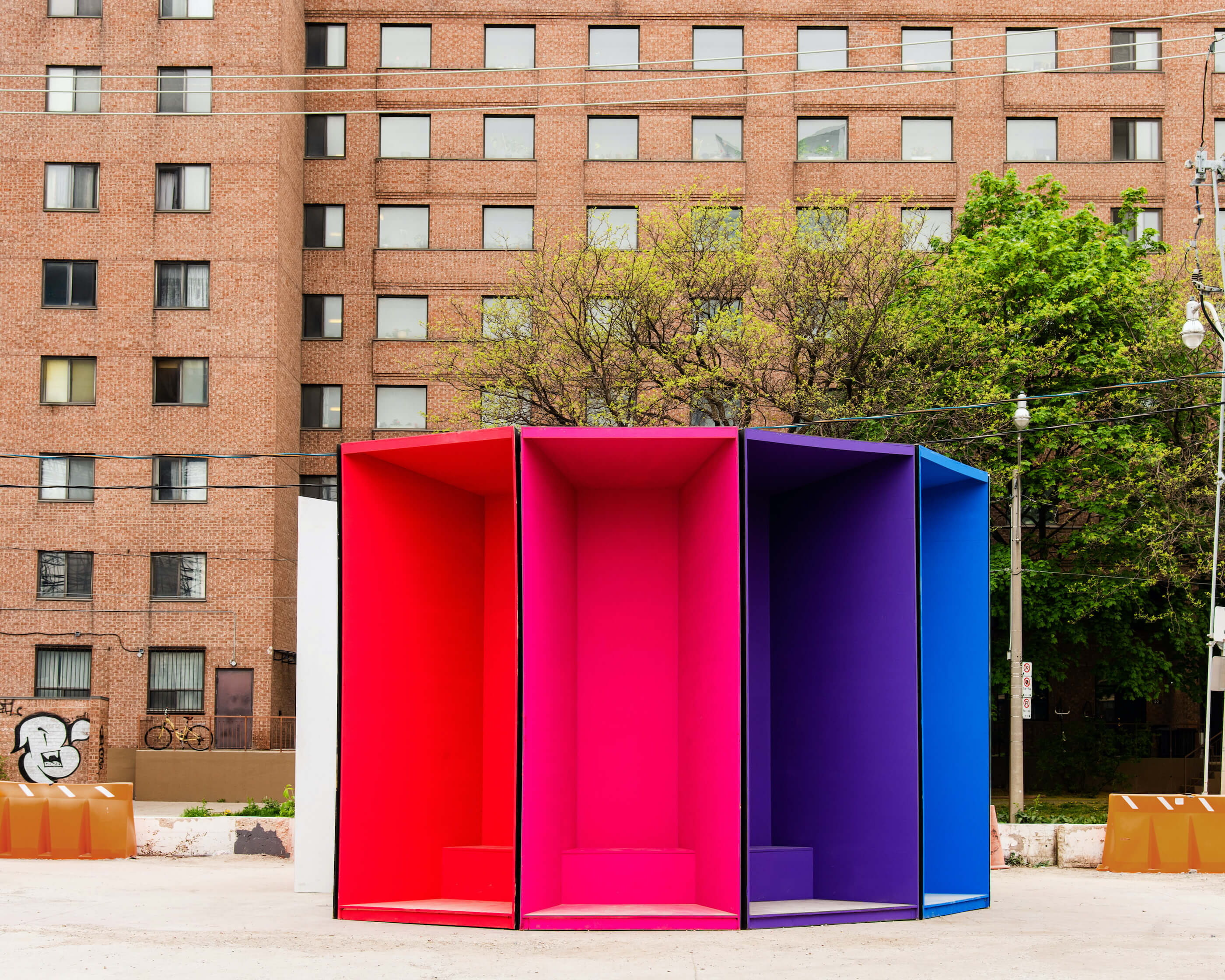A quartet of attention-grabbing temporary pavilions conceived and fabricated for Toronto’s Winter Stations international design competition are now on public view, albeit a few months later and in different locaitons than past competition cycles.
The popular annual competition, established by RAW Design, Ferris + Associates, and Curio, uses public art as a means of luring bundled-up Torontonians and visitors alike to the city’s normally barren beaches during the winter months. Submitted entries must incorporate existing, seasonally disused lifeguard towers placed across the Lake Ontario shoreline into their respective designs.
That didn’t happen this year—the competition’s seventh iteration—due to the pandemic. Competition organizers, however, were undeterred and came together with partnering organizations to launch a special, first-of-its-kind Spring Stations edition that brings three of the winning installations not to the beach but to the Distillery District, a pedestrian zone east of downtown Toronto. A fourth installation will be on display at 33 Parliament Street, a mixed-use development just south of the Distillery District. All four installations, which respond to the 2021 competition theme of “refuge,” will be on public view through the end of July.
Reads the competition prompt:
For the Winter Stations 2021 edition, we may reflect back on the year we have left behind and consider what refuge means to each of us: a shelter; a place of comfort and security, a sanctuary. As a community we may offer refuge. As individuals, we may protect one another, providing respite from danger or insulation from harsh realities. Refuge evokes discovery and the idea of exploring remote places. It reflects a renewed appreciation of the outdoors, while highlighting the importance of our safe spaces.
Each Winter Station practically acts as a refuge from the elements, so this year we suggest design competitors play with the literal and figurative, exploring what refuge means as we re-examine the importance of public space. How can we evoke refuge in an exhibition that will necessitate physical distance between visitors? And how can we promote interactivity when our ability to relate with the stations may have to omit physical touch in the name of safety.
As noted in a press release, Summer Stations at The Beach Village BIA is tentatively scheduled for later this summer, and a venue for Embrace, the 2021 competition’s winning student design, is also being sought out by competition organizers and Sheridan College. In addition to the non-beachfront seasonal switch-up, this is also the first year that the competition has had an official online merch storefront; proceeds from sales will go directly to funding future Winter Stations competitions.
“The circumstances of the last year have forced us to get creative, but thankfully creativity is in the DNA of Winter Stations,” said Roland Rom Colthoff, founder of RAW Design, in a statement. “I can say that this year’s launch is certainly the warmest we’ve ever had in the seven years that Winter Stations has been active.”
Take a look at all four winning 2021 Winter—now Spring—Station installations below. Brief descriptions of each work are also included as provided by the competition.
The Epitonium
M. Yengiaba —Shahed M. Yengiabad, Elaheh M. Yengiabad, Alemeh M. Yengiabad and Mojtaba Anoosha | Iran

“Throughout history, humankind has always strived to learn and be inspired by nature to engage in new experiences and provide a better life for themselves and others. Nature is the source of inspiration for architects, artists and scientists. It’s our origin and destination. Including not only external environments such as clouds, trees, sea, mountains and animals, but also buildings, components and materials. By building structures with forms familiar to us, creating two-dimensional graphics, and architecture with thickness, depth and volume, it can complement nature and be part of it. The Epitonium creates a beautiful, functional landscape. This idea causes natural shelters to become a refuge. The design is inspired by epitonium, a type of seashell, and is in great harmony with its location.”
On view at The Distillery District
From Small Beginnings
Jack Leather and Charlie Leather | United Kingdom

“The great outdoors has been where many have found solace, perhaps unexpectedly so, over the past 12 months. A year like no other, great enjoyment has been found in returning to more holistic roots. From Small Beginnings hopes to seize this movement; whilst giving platform and space to embrace new opportunities ahead. Through shelves bearing a future forest, the installation allows visitors to seek refuge from harsher elements, whilst encountering strangers from a safe distance or enjoying quiet reflection. Only upon entering, the brighter interior is revealed; symbolic of the opportunities that rise from challenging periods. Like the seedlings, which can be replanted, we are all simply at the beginning of our journeys.
We encourage you to take a sapling with you, replant it, and continue its journey along with yours.”
On view at The Distillery District
ARc de Blob
Aleksandra Belitskaja, Ben James and Shaun McCallum | Austria/U.K.

“ARc de Blob is a colourful landmark: a point of orientation, interaction and refuge. This architectural object creatively mixes physical materials with the ability to digitally interact and connect through a Mixed Reality App. The installation creates incredible virtual worlds — a figurative refuge where we can interact, connect and play. The physical form references iconic architectural composition and elements; and is contrasted with colourful materials and patterns that create a warm and welcoming shelter. The arch itself acts as a frame for a virtual portal / refuge seen in Mixed Reality — a space of new digital worlds: creative environments designed to encourage visitors to play and interact together digitally and physically. Ultimately, the piece is an evolving mix of digital art and physical architecture that creates playful interactions between these realities.”
On view at The Distillery District
THROBBER
Heidundgriess —Alexandra Grieß and Jorel Heid | Germany

“The reasons why people seek refuge are as diverse as people themselves. They wait. The walk-in installation consists of 10 small trapezoidal rooms ‘shelters’, lined up next to each other, each in monochrome. In combination, they form the colour spectrum of a rainbow. Inside, the colours are reduced to grey. From an aerial view, it forms the shape of a ‘throbber,’ an icon used computer programs (waiting, buffering). This icon is adopted from digital to real world as a symbol for the active experience of time, a transition where different perspectives, longings, hopes and motivations come together. The installation is an invitation to perceive similarities and connections with others, despite individual differences.”
On view at 33 Parliament Street











